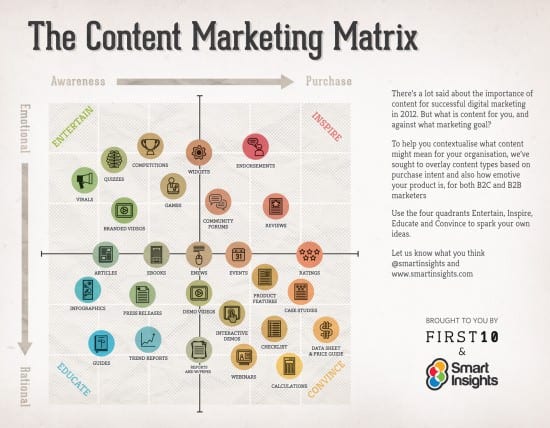Reviewing content strategy for your email marketing
It’s a simple equation. Provide sufficient value in your emails and customers will continue to welcome you into their inbox. Not enough and you’ll be ignored or banished. Value can be delivered in many forms, it isn’t just measured in pounds and dollars. A proven currency for value is content. But want content should you provide to whom across your email marketing?
Different email subscribers have different interests and needs depending on their characteristics and situation. The following matrix is taken from Dan’s post on generating content ideas. It provides an easy to use breakdown to review the options for different types of content for a defined segment or persona. You can use it to audit your current content and identify new content types to engage audiences at different points in the buying process.

If you’ve already a content editorial plan and an inventory of your content in place then you’re in a good place. You’ll just need to review to decide what content you can re-use and what additional content you might need to plan in specifically for email subscribers.
The ability to target in email marketing gives the opportunity to increase the power of content, by better matching the right content to the right person.
How can this be done?
The simplest segmentation model for content targeting is to target content on level of email engagement. This model is useful for two reasons:
- Everyone using a capable email solution has the data and the ability to use this approach.
- It’s based on behaviour, a better approach to targeting then using pure demographic or interest based data.
| Segment |
Engagement |
Content Targeting options |
| Proponent |
Regularly opening and clicking. Great, you’re trusted and content is valued. |
Content balance is good. Consider increasing Purchase based Inspire and Convince content. Such as testimonials, case studies and product videos, limited time deals. Send emails with Purchase only content and emails with mixed Awareness and Purchase content. Opportunity to increase frequency of contact. |
| Supporter |
Opening not clicking. You’ve still got attention but carry on like this and you’re going to be ignored. |
Increase Awareness content and retain a balance with Purchase content. Such as articles, industry reports and infographics.Send mostly emails with mixed Purchase and Awareness content. |
| Dormant |
Not opened or clicked for a long time. You’re being ignored. |
Focus on Awareness; Educate and Entertain, such as competitions, quizzes, guides and infographics.Also change subject line strategy. |
This model requires you to set time thresholds for how long to wait without an open or click before moving someone to a lower segment.
A good way to do this is to use your data and determine what normal behaviour is for your audience. What is the average time and variance in time between opens and clicks by individuals in your database? Set your thresholds based on this.
Likely values will be in the range 3 months to 6 months for Supporters and 6 months to 18 months for Dormants.
The best way to implement this lifecycle depends on your email platform. I find it helpful to keep automatically updated fields on the contact record for ‘last sent date’, ‘last open date’ and ‘last click date’. Then create segments using simple date based queries, such as, everyone not opened or click in the last N months.
The aim of your content based email strategy is to move people higher in the table. Check progress by reviewing counts for each segment every 3 months.
If you have a sufficient supply of value based content then review and test increasing your send frequency.
To up your game further and increase content targeting you’ll need to plan for more data. The amount of targeting should take into account additional costs vs value of targeting. Factors to consider are:
- Size of your list and diversity of audience
- The number of different content topics covered
- Range of your products and services
The more complex the situation the more increased content targeting provides value. Further content targeting parameters to use include:
- Status of relationship. Suspect, prospect, opportunity, customer?
- Content already viewed
- Known interests and job role (B2B)
- Products owned or enquired about
Use this data to create new targeting models or combine with the engagement behaviour model above.
Taking the case of having known areas of interest or targetable analysis of content viewed then overlay this on the simple model so that for each of Proponent, Supporter and Dormant segments the content topics are made more relevant for the individual. Think of it as a matrix like this, with different content defined for each of the cells:
|
Proponent |
Supporter |
Dormant |
| Interest A |
|
|
|
| Interest B |
|
|
|
| Interest C |
|
|
|
One way to implement the overlay is to use dynamic content. Create segments and creatives for each of Proponent, Supporter and Dormant. Then within each creative use dynamic content to target based on known areas or interest.
Ultimately, as with any strategy, the right approach is down to what is right for your situation.







